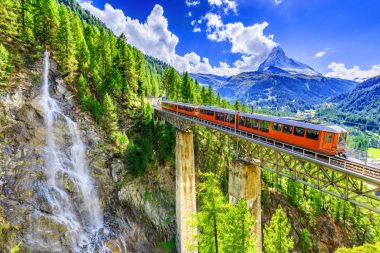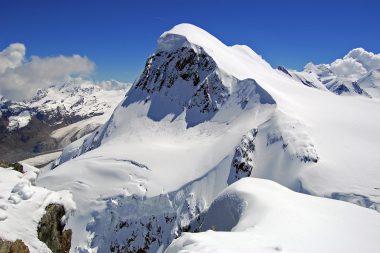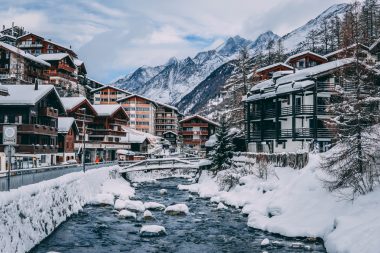High in the Valais Alps, the village of Zermatt lies beneath the incomparable and legendary Matterhorn. This imposing peak is an omnipresent and world-famous sight. There are plenty of photo vantage points around Zermatt and places where you can learn more about the people who conquered the mountain or died trying. There are also numerous other activities around Zermatt that are not only related to skiing and mountaineering.
The Matterhorn is just one of 29 peaks above 4,000 metres in the Upper Valais in Switzerland. And in this alpine playground, you can do things you might not have dreamed of, such as hiking across a glacier, skiing in the height of summer, and climbing one of the highest mountains in Europe. This is all made possible by record-breaking infrastructure, from ski lifts to cogwheel railways, that demonstrates human ingenuity in this extreme environment.
Summits & Excursions
The Matterhorn

This famous, jagged peak is engraved in the world’s consciousness as clearly as few other peaks in the world. This mountain, which is considered treacherous, was only conquered in 1865 and even then four of the seven climbers in the group died. Even the sight of the base camp at the Hörnlihütte and the steep slopes give an idea of what it must have been like for these early alpinists. The iconic, pyramid-shaped peak is a landmark that has gained worldwide fame and adorns countless postcards.
Little Matterhorn
The next peak besides the Matterhorn is the Kleine Matterhorn. This mountain rises to 3,883 meters and, amazingly, you can climb up there with an aerial tramway. It is the highest location in Europe that can be reached by this mode of transport. Once at the top, you reach the Matterhorn Glacier Paradise, where a tunnel leads to the Breithorn Plateau, a huge glacier on the south side of the summit. The temperatures are constantly below zero up here in Europe’s highest summer ski area, so warm clothing is recommended all year round. Treat yourself to a breathtaking impression and be sure to descend into the glacier grotto!
Breithorn

If you want to shine in front of your friends and tell them that you have climbed a 4,000-meter-high mountain, you can climb the Breithorn. What you don’t have to tell them is that this peak is considered the easiest to climb of all four-thousand-metre peaks. All you need is a qualified mountain guide, and the adventure begins after climbing the Little Matterhorn by cable car. From there, it’s a three-hour tour to and from the highest point of the Breithorn. While the hike is never too strenuous, the slopes are glaciated, and the air is of course much thinner at this altitude.
Gornergrat
One of the most memorable excursions in Zermatt is a ride on the highest open-air cogwheel railway in Europe. The Gornergrat Railway commutes to the Gornergrat viewing platform, a little more than 3,000 metres above sea level, through a breathtaking mountain wilderness in which no fewer than 29 peaks rise over 4,000 metres. It may be hard to believe, but the railroad was built back in 1896, making it the world’s first fully electrified rack railway. The journey takes 33 minutes and the train travels over gorges and through pine and larch forests. You will then reach the observation deck, which is located in the middle of a small tourist facility and whose scenery and view are indescribable.
Skiing in Zermatt

In the shadow of the Matterhorn lies of course also the ultimate destination for a ski holiday. Zermatt is the hub of a network of 54 cable cars, lifts and mountain railways and more than 360 kilometres of slopes. As we have already seen on the Breithorn plateau, skiing is possible even in the height of summer due to the glaciers and the low temperatures at high altitude. Lower slopes are already covered with snow in November and April for a longer season. If you like it more intrepid, you can hire a mountain guide who knows the terrain like the back of his hand and accompanies you beyond the slopes.
[table id=”1″ /]Zermatt Centre
With so many beauties in the area, don’t forget to spend some time in the car-free and romantic alleys of Zermatt. Much of the village’s history can be traced back to early tourism and alpinism, such as the Monte Rosa Hotel, the oldest hotel in Zermatt, which opened in 1855 and where Edmund Whymper and the rest of his team stayed before the first ascent of the Matterhorn. The “Old Village” looks like a large open-air museum consisting of about 30 typical Walser houses.
Gorner Gorge
About 15 minutes walk from Zermatt is an imposing landform that slopes mercilessly as a gorge. Since the last ice age, the glacial river Gornervispe has cut through the ancient and green-colored serpentine rock to create an ever-deepening gorge. In the 1880s, the gorge was made accessible on foot and wooden walkways provide wonderful views of the tormented rock and the crystal clear waters below. In September, there is a curious natural phenomenon between 3:00 p.m. and 4:00 p.m.: on some days, a unique light gives the water a mesmerizing turquoise glow.
As you can see, the area around Zermatt offers more than just an impressive mountain world. Pure nature, breathtaking views, romantic houses and alleys and many sporting activities let every guest enjoy what they need for a wonderful and unforgettable holiday in one of the most beautiful places in Switzerland.




